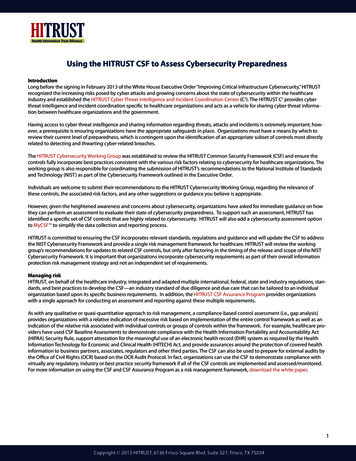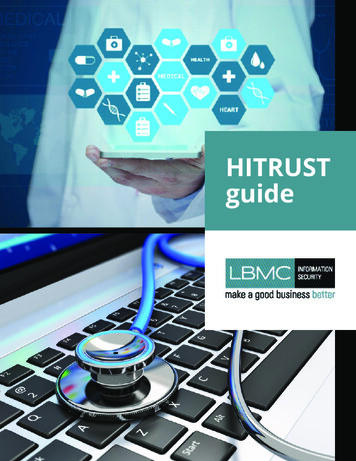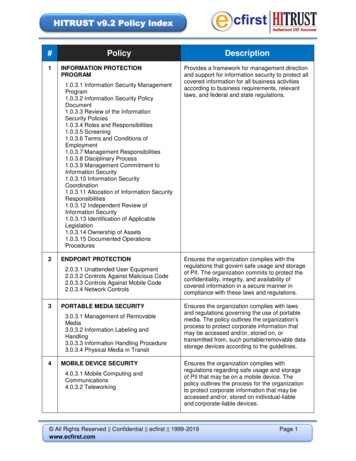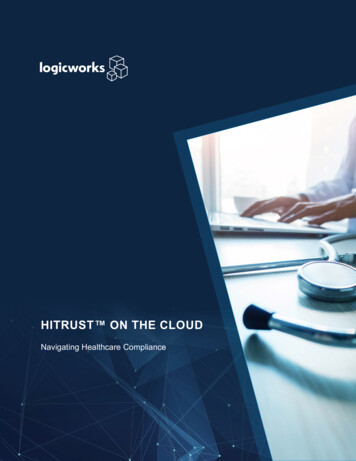
Transcription
HITRUSTUsing the HITRUST CSF to Assess Cybersecurity PreparednessIntroductionLong before the signing in February 2013 of the White House Executive Order “Improving Critical Infrastructure Cybersecurity,” HITRUSTrecognized the increasing risks posed by cyber attacks and growing concerns about the state of cybersecurity within the healthcareindustry and established the HITRUST Cyber Threat Intelligence and Incident Coordination Center (C3). The HITRUST C3 provides cyberthreat intelligence and incident coordination specific to healthcare organizations and acts as a vehicle for sharing cyber threat information between healthcare organizations and the government.Having access to cyber threat intelligence and sharing information regarding threats, attacks and incidents is extremely important; however, a prerequisite is ensuring organizations have the appropriate safeguards in place. Organizations must have a means by which toreview their current level of preparedness, which is contingent upon the identification of an appropriate subset of controls most directlyrelated to detecting and thwarting cyber-related breaches.The HITRUST Cybersecurity Working Group was established to review the HITRUST Common Security Framework (CSF) and ensure thecontrols fully incorporate best practices consistent with the various risk factors relating to cybersecurity for healthcare organizations. Theworking group is also responsible for coordinating the submission of HITRUST’s recommendations to the National Institute of Standardsand Technology (NIST) as part of the Cybersecurity Framework outlined in the Executive Order.Individuals are welcome to submit their recommendations to the HITRUST Cybersecurity Working Group, regarding the relevance ofthese controls, the associated risk factors, and any other suggestions or guidance you believe is appropriate.However, given the heightened awareness and concerns about cybersecurity, organizations have asked for immediate guidance on howthey can perform an assessment to evaluate their state of cybersecurity preparedness. To support such an assessment, HITRUST hasidentified a specific set of CSF controls that are highly related to cybersecurity. HITRUST will also add a cybersecurity assessment optionto MyCSF to simplify the data collection and reporting process.HITRUST is committed to ensuring the CSF incorporates relevant standards, regulations and guidance and will update the CSF to addressthe NIST Cybersecurity Framework and provide a single risk management framework for healthcare. HITRUST will review the workinggroup’s recommendations for updates to related CSF controls, but only after factoring in the timing of the release and scope of the NISTCybersecurity Framework. It is important that organizations incorporate cybersecurity requirements as part of their overall informationprotection risk management strategy and not an independent set of requirements.Managing riskHITRUST, on behalf of the healthcare industry, integrated and adapted multiple international, federal, state and industry regulations, standards, and best practices to develop the CSF—an industry standard of due diligence and due care that can be tailored to an individualorganization based upon its specific business requirements. In addition, the HITRUST CSF Assurance Program provides organizationswith a single approach for conducting an assessment and reporting against these multiple requirements.As with any qualitative or quasi-quantitative approach to risk management, a compliance-based control assessment (i.e., gap analysis)provides organizations with a relative indication of excessive risk based on implementation of the entire control framework as well as anindication of the relative risk associated with individual controls or groups of controls within the framework. For example, healthcare providers have used CSF Baseline Assessments to demonstrate compliance with the Health Information Portability and Accountability Act(HIPAA) Security Rule, support attestation for the meaningful use of an electronic health record (EHR) system as required by the HealthInformation Technology for Economic and Clinical Health (HITECH) Act, and provide assurances around the protection of covered healthinformation to business partners, associates, regulators and other third parties. The CSF can also be used to prepare for external audits bythe Office of Civil Rights (OCR) based on the OCR Audit Protocol. In fact, organizations can use the CSF to demonstrate compliance withvirtually any regulatory, industry or best practice security framework if all of the CSF controls are implemented and assessed/monitored.For more information on using the CSF and CSF Assurance Program as a risk management framework, download the white paper.1Copyright 2013 HITRUST, 6136 Frisco Square Blvd. Suite 327, Frisco, TX 75034
HITRUSTOrganizations should note that any security control framework, whether it be the HITRUST CSF, NIST’s Special Publication (SP) 800-53, orthe International Standards Organization (ISO) 27002 controls, must be implemented fully—or as much as it can be legitimately tailoredby the organization—in order to provide an acceptable reduction in risk. As an example, merely focusing on the OCR Audit Protocol requirements will not ensure an adequate level of protection for covered information as required under HIPAA. Such a focused assessmentwill only provide an organization a level of assurance around the implementation of the specific requirements addressed. The OCR AuditProtocol does not address all the HIPAA Security Rule implementation specifications, which would be required to support the attestationof meaningful use. However, it’s clear that these relatively limited assurances are extremely important, as they address specific risk issuesconsidered to be of high interest to executive leadership, such as with HIPAA compliance, meaningful use or OCR audits, as already mentioned, or for assurances regarding more recent concerns such as cybersecurity.Cybersecurity preparednessOn February 13, 2013, President Obama issued the Executive Order on “Improving Critical Infrastructure Cybersecurity” and directed thedirector of NIST to lead the development of a framework to reduce cyber risks to critical infrastructure, of which healthcare is a part. Thenew Cybersecurity Framework will incorporate existing consensus-based standards such as the CSF to the fullest extent possible in orderto address concerns raised by the Government Accountability Office (GAO) in its December 2011 report “Critical Infrastructure Protection:Cybersecurity Guidance is Available, but More Can Be Done to Promote Its Use.” In its report, the GAO found similarities in cybersecurityguidance and practices across multiple sectors, even though much of this guidance is tailored to business needs or to address uniquerisks and operations, and recommended promoting existing guidance to assist individual entities within a sector to identify the “guidancethat is most applicable and effective in improving their security posture.”As noted above, HITRUST recognized the implications cyber attacks pose on the healthcare industry, both with regards to safety andprivacy, and established the HITRUST Cyber Threat Intelligence and Incident Coordination Center (C3) a year ago. But given the increasing volume, sophistication and risks associated with cyber attacks perpetrated on healthcare organizations and increased awareness bylegislators and regulators, HITRUST believes there is real value in providing additional guidance to organizations wanting to review theircurrent level of preparedness.The CSF already incorporates the controls that would address cybersecurity threats and notes that any assessment should be incorporated into an organization’s broader risk and regulatory compliance and assessment strategy. But given the heightened sensitivity andincreasing threat, organizations may want to perform an assessment that focuses specifically on cybersecurity. As such, HITRUST hasidentified specific CSF controls that are highly related to cybersecurity—or more specifically to the prevention of cyber intrusions byexternal human threat actors and their identification and response when preventative safeguards fail.2Copyright 2013 HITRUST, 6136 Frisco Square Blvd. Suite 327, Frisco, TX 75034
HITRUSTCybersecurity controlsHITRUST considered healthcare industry breach data and external guidance on safeguards related to cybersecurity to determine thisinitial set of cyber-related controls. The table below separates all 135 CSF controls into three categories based on their assessed relevanceto cybersecurity threats: most relevant, relevant and least relevant.CSF Controls - Most RelevantCSF Controls - Relevant(Requires Further AnalysisCSF Controls - Least Relevant01.a* - Access Control Policy0.a*- Information Security ManagementProgram01.g – Unattended User Equipment01.b* - User Registration01.c – Privilege Management01.h – Clear Desk and Clear Screen Policy01.d* - User Password Management01.e – Review of User Access Rights01.k – Equipment Identification inNetworks01.f* - Review of User Access Rights01.l – Remote Diagnostic andConfiguration Port Protection01.p – Secure Log-on Procedures01.i* - Policy on the User of NetworkServices01.s – Use of System Utilities01.t – Session Time-out01.j* - User Authentication for ExternalConnections01.y – Teleworking01.u – Limitation of Connection Time01.m* - Segregation in Networks02.a* - Roles and Responsibilities02.b – Screening01.n* - Network Connection Control03.a* - Risk Management ProgramDevelopment02.c – Terms and Conditions ofEmployment01.o* - Network Routing Control03.d – Risk Evaluation02.d – Management Responsibilities01.q* - User Identification andAuthentication04.a* - Information Security PolicyDocument02.f* - Disciplinary Process01.r* - Password Management System05.a* - Management Commitment toInformation Security02.g – Termination or ChangeResponsibilities01.v* - Information Access Restriction05.b* - Information Security Coordination02.h – Return of Assets01.w* - Sensitive System Isolation05.f – Contact with Authorities04.b* - Review of the Information SecurityPolicy01.x* - Mobile Computing andCommunications05.g – Contact with Special Interest Groups05.c – Allocation of Information SecurityResponsibilities02.e* - Information Security Awareness,Education and Training05.i* - Identification of Risks Related toExternal Parties05.d – Authorization Process forInformation Assets and Facilities02.i* - Removal of Access Rights05.k* - Addressing Security in Third PartyAgreements05.e – Confidentiality Agreements03.b* - Performing Risk Assessments06.b – Intellectual Property Rights05.h – Independent Review of InformationSecurity03.c* - Risk Mitigation06.f – Regulation of Cryptographic Controls 05.j – Addressing Security When Dealingwith Customers06.d* - Data Protection and Privacy ofCovered Information06.j – Protection of Information SystemsAudit Tools06.a – Identification of ApplicableLegislation06.e* - Prevention of Misuse of InformationAssets07.c* - Acceptable Use of Assets06.c – Protection of Organizational Records06.g* - Compliance with Security Policiesand Standards07.d – Classification Guidelines06.i – Information System Audit Controls06.h – Technical Compliance Checking07.e – Information Labeling and Handling07.b – Ownership of Assets07.a* - Inventory of Assets08.j* - Equipment Maintenance08.a – Physical Security Perimeter09.b*** - Change Management08.l* - Secure Disposal or Re-use ofEquipment08.b* - Physical Entry Controls09.j* - Controls against Malicious Code09.c*- Segregation of Duties08.c – Securing Offices, Rooms andFacilities3Copyright 2013 HITRUST, 6136 Frisco Square Blvd. Suite 327, Frisco, TX 75034
HITRUSTCSF Controls - Most RelevantCSF Controls - Relevant(Requires Further AnalysisCSF Controls - Least Relevant09.k – Controls Against Mobile Code09.d – Separation of Development, Test and 08.d* - Protecting Against External andOperational EnvironmentsEnvironmental Threats09.l*** - Back-up09.h – Capacity Management08.e – Working in Secure Areas09.m* - Network Controls09.o* - Management of Removable Media08.f – Public Access, Delivery and LoadingAreas09.n** - Security of Network Services09.w – Interconnected BusinessInformation Systems08.g – Equipment Siting and Protection09.q* - Information Handling Procedures10.c – Control of Internal Processing08.h – Supporting Utilities09.s* - Information Exchange Policies andProcedures10.e – Output Data Validation08.i – Cabling Security09.v – Electronic Messaging10.g – Key Management08.k – Security of Equipment Off-premises09.x – Electronic Commerce Services10.l* - Outsourced Software Development08.m – Removal of Property09.y – On-line Transactions11.d – Learning from Information SecurityIncidents09.a – Documented Operations Procedures09.aa* - Audit Logging11.e – Collection of Evidence09.e* - Service Delivery09.ab* - Monitoring System Use12.a – Including Info. Security in the Business Continuity Mgmt. Process09.f* - Monitoring and Review of ThirdParty Services09.ac* - Protection of Log Information12.b – Business Continuity and RiskAssessment09.g* - Managing Changes to Third PartyServices09.ad – Administrator and OperatorLogs12.e – Testing, Maintaining and Reassessing 09.i – System AcceptanceBusiness Continuity Plans09.ae – Fault Logging09.p* - Disposal of Media09.af* - Clock Synchronization09.r – Security of System Documentation10.a – Security Requirements Analysisand Specification09.t – Exchange Agreements10.b* - Input Data Validation09.u – Physical Media in Transit10.f* – Policy on the Use of CryptographicControls09.z – Publically Available Information10.h* - Control of Operational Software10.d – Message Integrity10.k*** - Change Control Procedures10.i – Protection of System Test Data10.m* - Control of Technical Vulnerabilities10.j – Access Control to Program SourceCode11.a* - Reporting Information SecurityEvents12.d – Business Continuity PlanningFramework11.b – Reporting Security Weaknesses11.c* - Responsibilities and Procedures12.c* - Developing & ImplementingContinuity Plans Incl. Info. Security* - Control required for CSF 2013 (v5) Certification** - Control proposed for Certification in the mid-2013 CSF release (v5.1) (text also italicized)*** - Control proposed for CSF 2014 (v6) Certification (text also italicized)Bold text – Controls deemed critical to cybersecurity but have not been identified for future inclusion in the controls required for CSFCertification4Copyright 2013 HITRUST, 6136 Frisco Square Blvd. Suite 327, Frisco, TX 75034
HITRUSTThe initial set of 50 “critical” cybersecurity controls identified in the first column of the table includes 37 controls already required for2013 certification, one (1) control identified for certification with the upcoming mid-2013 CSF release, and three (3) controls identified forcertification in 2014. Nine (9) controls are not currently being considered as a certification requirement.It’s important to note once again that the assessment of the cybersecurity controls presented here addresses a different question than—using our previous example—the controls that map to the OCR Audit Protocol. While both have CSF controls in common such as 01.a,01.b and 01.c, which are related to access control, there are other controls for which they do not. For example cybersecurity-relevantcontrols not shared with the OCR Audit Protocol include technical vulnerability management controls such as 10.m and change management controls such as 10.h and 10.k. OCR Audit Protocol controls not shared with cybersecurity include physical and environmentalcontrols such as 08.a, 08.b, 08.c, 08.e, 08.g, 08.j, 08.l and 08.m. As long as one understands the question that frames the control selection–how to prevent cyber intrusions by external human threat actors and their identification and response when preventative safeguardsfail— the assurances obtained from an assessment of the selected controls have significant value.HITRUST Cybersecurity Working GroupHITRUST would like your input regarding the relevance of these controls to cybersecurity, recommended risk factors and CSF implementation levels (1, 2 or 3), and any other suggestions or guidance you believe is appropriate. Please be prepared to discuss these issues atthe Cybersecurity Working Group meeting on May 22, 2013, at the conclusion of the HITRUST 2013 annual conference.Results from the Working Group meeting will be used in HITRUST’s proposal to NIST for a recommended healthcare cybersecurity framework and related set of best practices. If you are not participating in the working group, please provide written comments toworkgroup@hitrustalliance.net no later than Wednesday, May 15, 2013, to allow adequate time for updating the strawman before theMay 22 meeting.More information on the HITRUST Cybersecurity Working Group can be found at hitrustalliance.net/cyberwg.5Copyright 2013 HITRUST, 6136 Frisco Square Blvd. Suite 327, Frisco, TX 75034
HITRUST is committed to ensuring the CSF incorporates relevant standards, regulations and guidance and will update the CSF to address the NIST Cybersecurity Framework and p











